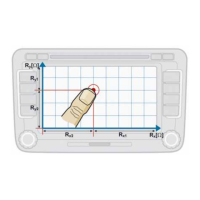32
RNS 510 Radio/Navigation System
How the touch screen works
The touch screen used on the RNS 510 radio
navigation system works according to the resistive
principle. This means that the touch recognition uses
resistance-based technology.
When you touch the touch screen, the outer glass
layer is pressed against the glass base layer. The two
indium tin oxide coatings, which are separated by the
spacer dots when the screen is not touched, come into
electrical contact.
To simplify explanation, you can imagine the touch-
sensitive surface that is formed by the two indium tin
oxide-coated glass layers as a coordinate system.
Each touch point on this surface can be located with a
horizontal and vertical distance from the edge of the
monitor. Electrical resistances are used as values for
the horizontal and vertical distances.
A horizontal and vertical coordinate value is
determined by current flow direction of the two
coatings being turned 90° towards each other.
A direct voltage of 5 volts is applied 25 times per
second alternating to the upper or lower indium tin
oxide layer.
The touch screen signals are evaluated via a separate
controller in the radio/navigation system.
Base layer made from glass
Spacer dots
Indium tin oxide layer
Outer glass layer
Touch point
Indium tin oxide layers
S397_029
S397_026
S397_027

